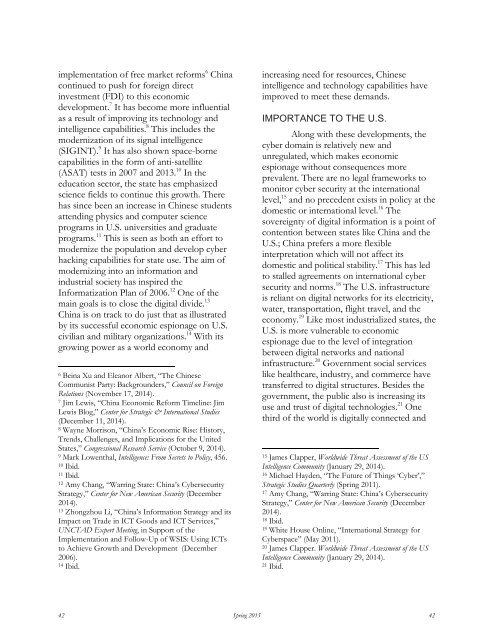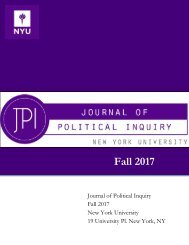JPI Spring 2015
Create successful ePaper yourself
Turn your PDF publications into a flip-book with our unique Google optimized e-Paper software.
implementation of free market reforms 6 China<br />
continued to push for foreign direct<br />
investment (FDI) to this economic<br />
development. 7 It has become more influential<br />
as a result of improving its technology and<br />
intelligence capabilities. 8 This includes the<br />
modernization of its signal intelligence<br />
(SIGINT). 9 It has also shown space-borne<br />
capabilities in the form of anti-satellite<br />
(ASAT) tests in 2007 and 2013. 10 In the<br />
education sector, the state has emphasized<br />
science fields to continue this growth. There<br />
has since been an increase in Chinese students<br />
attending physics and computer science<br />
programs in U.S. universities and graduate<br />
programs. 11 This is seen as both an effort to<br />
modernize the population and develop cyber<br />
hacking capabilities for state use. The aim of<br />
modernizing into an information and<br />
industrial society has inspired the<br />
Informatization Plan of 2006. 12 One of the<br />
main goals is to close the digital divide. 13<br />
China is on track to do just that as illustrated<br />
by its successful economic espionage on U.S.<br />
civilian and military organizations. 14 With its<br />
growing power as a world economy and<br />
6 Beina Xu and Eleanor Albert, “The Chinese<br />
Communist Party: Backgrounders,” Council on Foreign<br />
Relations (November 17, 2014).<br />
7 Jim Lewis, “China Economic Reform Timeline: Jim<br />
Lewis Blog,” Center for Strategic & International Studies<br />
(December 11, 2014).<br />
8 Wayne Morrison, “China’s Economic Rise: History,<br />
Trends, Challenges, and Implications for the United<br />
States,” Congressional Research Service (October 9, 2014).<br />
9 Mark Lowenthal, Intelligence: From Secrets to Policy, 456.<br />
10 Ibid.<br />
11 Ibid.<br />
12 Amy Chang, “Warring State: China’s Cybersecurity<br />
Strategy,” Center for New American Security (December<br />
2014).<br />
13 Zhongzhou Li, “China’s Information Strategy and its<br />
Impact on Trade in ICT Goods and ICT Services,”<br />
UNCTAD Expert Meeting, in Support of the<br />
Implementation and Follow-Up of WSIS: Using ICTs<br />
to Achieve Growth and Development (December<br />
2006).<br />
14 Ibid.<br />
increasing need for resources, Chinese<br />
intelligence and technology capabilities have<br />
improved to meet these demands.<br />
IMPORTANCE TO THE U.S.<br />
Along with these developments, the<br />
cyber domain is relatively new and<br />
unregulated, which makes economic<br />
espionage without consequences more<br />
prevalent. There are no legal frameworks to<br />
monitor cyber security at the international<br />
level, 15 and no precedent exists in policy at the<br />
domestic or international level. 16 The<br />
sovereignty of digital information is a point of<br />
contention between states like China and the<br />
U.S.; China prefers a more flexible<br />
interpretation which will not affect its<br />
domestic and political stability. 17 This has led<br />
to stalled agreements on international cyber<br />
security and norms. 18 The U.S. infrastructure<br />
is reliant on digital networks for its electricity,<br />
water, transportation, flight travel, and the<br />
economy. 19 Like most industrialized states, the<br />
U.S. is more vulnerable to economic<br />
espionage due to the level of integration<br />
between digital networks and national<br />
infrastructure. 20 Government social services<br />
like healthcare, industry, and commerce have<br />
transferred to digital structures. Besides the<br />
government, the public also is increasing its<br />
use and trust of digital technologies. 21 One<br />
third of the world is digitally connected and<br />
15 James Clapper, Worldwide Threat Assessment of the US<br />
Intelligence Community (January 29, 2014).<br />
16 Michael Hayden, “The Future of Things ‘Cyber’,”<br />
Strategic Studies Quarterly (<strong>Spring</strong> 2011).<br />
17 Amy Chang, “Warring State: China’s Cybersecurity<br />
Strategy,” Center for New American Security (December<br />
2014).<br />
18 Ibid.<br />
19 White House Online, “International Strategy for<br />
Cyberspace” (May 2011).<br />
20 James Clapper. Worldwide Threat Assessment of the US<br />
Intelligence Community (January 29, 2014).<br />
21 Ibid.<br />
42 <strong>Spring</strong> <strong>2015</strong> 42
















